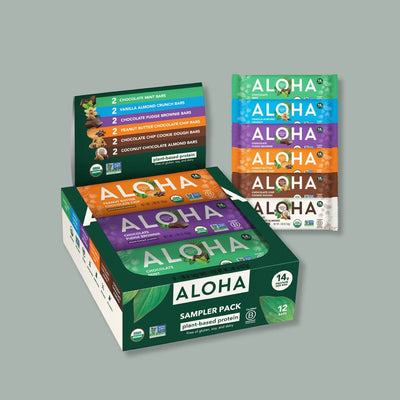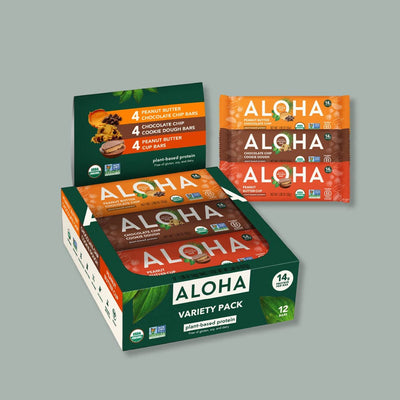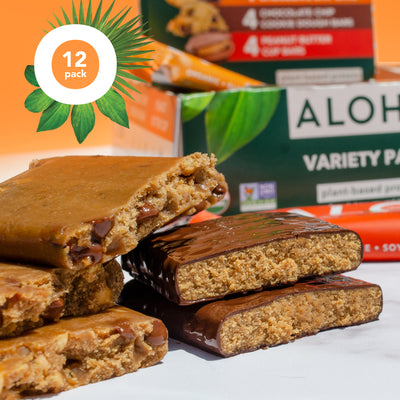Key Takeaways:
- Protein Coffee Combines Energy and Nutrition: Protein coffee blends caffeine and protein to offer sustained energy, muscle support, and a satisfying start to your day.
- It’s Easy to Customize: With various protein flavors, milk alternatives, and optional add-ins like cinnamon or honey, protein coffee suits every taste.
- Ideal for Busy Lifestyles: Quick to make and versatile, protein coffee is perfect for busy mornings, pre-workout routines, or midday pick-me-ups.
At ALOHA, we believe that healthy choices should be simple and satisfying. Our plant-based protein powders are packed with organic, clean ingredients designed to empower your wellness journey without sacrificing taste.
What if your morning coffee could do more than just wake you up? Imagine it fueling your body, curbing hunger, and helping you stay on top of your wellness goals—all in one delicious sip. Protein coffee makes that possible, blending energy and nutrition into the perfect morning pick-me-up.
In this piece, we’ll guide you step-by-step to make a protein coffee that’s as easy as energizing. You’ll discover how to turn your morning cup into a nourishing ritual that supports your wellness goals and tastes amazing.
What Is Protein Coffee?
Protein coffee is a delicious and functional blend of coffee and protein, crafted to deliver the best of both worlds. It combines the energy-boosting power of caffeine with the muscle-nourishing and hunger-satisfying benefits of protein. This makes it ideal for anyone looking to start their day strong or stay fueled during busy mornings.
Think of it as the ultimate multitasker for your wellness routine. Whether heading to the gym, tackling work, or just trying to stay energized, protein coffee offers a balanced and flavorful way to support your goals. Its versatility and simplicity make it easy to see why this trend is brewing in popularity.
Benefits Of Adding Protein To Your Coffee
Protein coffee offers a unique blend of energy and nutrition, making it more than just your average morning beverage. Beyond the bold flavor of coffee, adding protein turns your drink into a functional powerhouse that can support various wellness goals. Let’s break down the key benefits:
Sustained Energy Throughout The Day
While caffeine gives you a quick energy boost, the protein helps stabilize blood sugar levels, preventing the dreaded mid-morning crash. This means you’ll stay energized and focused longer without feeling jittery. Together, they create a balanced energy source that powers you through even your busiest days.
Support For Muscle Recovery And Growth
Protein is vital in repairing and building muscle, making protein coffee an excellent choice for post-workout recovery. By incorporating a high-quality, plant-based protein powder, you’re fueling your body with the nutrients it needs to rebuild and stay strong. It’s a simple way to care for your body without adding extra steps to your routine.
Longer Lasting Fullness
Protein is known for its ability to keep you feeling full and satisfied, curbing hunger cravings throughout the morning. When combined with coffee, it becomes a satisfying breakfast option for people on the go. This benefit is perfect for those who want to avoid unhealthy snacking before lunch.
Convenient And Time-Saving
For busy mornings, protein coffee is a game-changer. Instead of preparing breakfast and coffee separately, you get a nutrient-packed solution in one cup. It’s the ultimate time-saver for those juggling work, workouts, and life.
An Easy Way To Boost Nutrition
Adding protein to coffee is an effortless way to upgrade your daily nutrition. Especially when using a clean, plant-based option like ALOHA’s protein powders, you give your body essential nutrients without complicating your routine. It’s a small change that can make a big difference over time.
Essential Ingredients For Protein Coffee
Making protein coffee is simple, but starting with the right ingredients is crucial in creating a delicious and nutritious drink. Each ingredient serves a purpose, whether it’s boosting flavor, energy, or nutritional value. Here’s what you’ll need:
- High-Quality Coffee: Start with a fresh, high-quality coffee base—hot or cold brew works, depending on your preference. The coffee's rich, bold flavor forms the perfect canvas for your protein mix. Plus, caffeine provides that essential energy boost to kickstart your day.
- Plant-Based Protein Powder: Choose a clean, plant-based protein powder, like ALOHA’s, for a smooth and natural flavor. Look for options that are free from artificial sweeteners and packed with nutrients to keep your drink wholesome. This adds muscle-repairing and hunger-satisfying benefits to your coffee.
- Milk or Milk Alternative: For a creamier texture, add your favorite milk or plant-based alternative. Almond, oat, or coconut milk pairs beautifully with coffee and protein powder, enhancing the flavor without overpowering it. This addition also helps create a satisfying, latte-like consistency.
- Sweetener of Choice (Optional): If you prefer your coffee sweeter, add a natural sweetener like honey or maple syrup. Keep it light to avoid overpowering the coffee and protein flavors. This step is completely optional but can add a touch of indulgence to your drink.
Step-By-Step Guide To Making Protein Coffee
Making protein coffee at home is simple and rewarding, combining energy and nutrition into one delicious cup. With just a few easy steps, you can craft a drink tailored to your taste that supports your health goals. Follow these instructions to create the perfect protein coffee:
1. Brew Your Coffee
Start by preparing a fresh cup of your favorite coffee using your preferred brewing method. Whether you enjoy the warmth of a hot coffee or the chill of a cold brew, both options work well for this recipe. Ensure the coffee is strong enough to complement and balance the protein powder flavors.
2. Mix In Protein Powder
Measure one scoop of protein powder, choosing plant-based if you prefer. Slowly stir it into your coffee, using a spoon for thorough mixing or a handheld frother for a smoother, lump-free consistency. Adding protein powder enhances the nutritional value and gives your coffee a creamy and rich texture.
3. Add Milk Or Creamer
Enhance the flavor by adding your favorite milk or a plant-based alternative, such as almond, oat, or coconut milk. This addition creates a silky, latte-like consistency, making your coffee more enjoyable. Adjust the quantity based on how creamy you like your drink to be.
4. Sweeten (Optional)
If you enjoy a touch of sweetness, incorporate a natural sweetener like honey or maple syrup. Begin with a small amount and adjust to taste, ensuring it doesn’t overpower the coffee's natural flavors. Remember, some protein powders are already sweetened, so check before adding extra sugar.
5. Blend Or Shake (Optional)
For a frothy, café-style drink, blend your protein coffee in a blender or shake it in a blender bottle. This step is especially useful for cold coffee, ensuring all ingredients are fully combined. The result is a smooth, professionally blended beverage that looks and tastes like it came from your favorite coffee shop.
Tips For Enhancing Your Protein Coffee Experience
Making protein coffee is straightforward, but you can transform it into a delicious and unique beverage with creativity. You can tailor your drink to suit your preferences and health goals by experimenting with flavors, textures, and add-ins. Here are some tips to elevate your protein coffee:
Experiment With Different Protein Flavors
Try using flavored protein powders such as chocolate, vanilla, caramel, or even mocha to add variety to your coffee. Each flavor offers a unique twist, making your drink feel like a special treat rather than just a daily routine. For a gourmet experience, pair chocolate protein with a cold brew or vanilla with hot coffee to mimic classic café-style beverages.
Adjust The Consistency
If you want a velvety, rich texture, blend your ingredients instead of simply stirring them together. Using a blender or frother ensures a lump-free mix and creates a creamy consistency with a frothy top, much like a barista-made latte. This method is particularly effective if you add extras like nut butters, creamers, or ice cubes.
Add Nutrient Boosters
Add a pinch of cinnamon, turmeric, or cocoa powder to enhance your protein coffee's flavor and nutritional value. These ingredients improve the taste and provide antioxidants and anti-inflammatory benefits. For an extra energy boost, include a teaspoon of MCT oil or a sprinkle of chia seeds for added fiber.
Play With Temperature
Switching between hot and iced protein coffee can keep your routine exciting and adaptable to the season. Hot protein coffee is perfect for cozy mornings or chilly days, while an iced version offers a refreshing pick-me-up during warmer weather. Preparing a batch of cold brew in advance can make it easier to whip up iced protein coffee in seconds.
Try Different Plant-Based Milks
Explore various plant-based milk options, such as almond, oat, soy, or coconut, to find the one that best complements your coffee. Each type has a distinct flavor and creaminess level, allowing you to customize the overall taste of your drink. For example, coconut milk lends a tropical note, oat milk provides a neutral and smooth base, and almond milk adds a nutty undertone.
Best Times To Enjoy Protein Coffee
Protein coffee is versatile enough to fit into any part of your day, but it maximizes its benefits at certain times. Whether you’re fueling a workout or need an energy boost, protein coffee can be your go-to drink. Let’s explore the best moments to enjoy it:
First Thing In The Morning
Starting your day with protein coffee can help kickstart your metabolism and keep you feeling full until your next meal. The combination of caffeine and protein provides sustained energy, making it perfect for busy mornings. It’s a quick and satisfying breakfast solution for people on the go.
Pre-Workout Fuel
Drinking protein coffee before a workout can give you the energy to perform your best. The caffeine boosts focus and stamina, while the protein primes your muscles for activity. It’s an excellent choice if you prefer lighter, fast-digesting fuel before hitting the gym.
Mid-Morning Pick-Me-Up
If you’ve already had breakfast, protein coffee makes a great mid-morning snack to tide you over until lunch. It helps curb hunger cravings while keeping your energy steady. This is a healthier alternative to sugary snacks or another plain cup of coffee.
Post-Workout Recovery
After a workout, protein coffee can aid in muscle repair and replenish your energy levels. The protein helps rebuild muscle, while the caffeine can reduce post-exercise fatigue. Pairing it with a healthy meal enhances its recovery benefits.
Final Thoughts
Protein coffee represents a seamless blend of function and flavor, proving that wellness doesn’t have to be complicated. By incorporating this simple addition into your routine, you can transform your morning coffee into a purposeful ritual that energizes your body and supports your goals. It’s not just about mixing coffee and protein; it’s about embracing a more mindful approach to your daily habits prioritizing health without sacrificing the joy of indulgence.
This concept goes beyond trends—it’s a testament to how small, intentional changes can create significant impacts. Protein coffee encourages you to rethink how nourishment fits your lifestyle, offering a versatile and accessible way to fuel your day. Whether seeking sustained energy, a satisfying start, or an easy nutritional boost, this innovation invites you to make each sip count.
Read also:
- Meal Replacement Smoothies: How To Make And Enjoy Them
- Vegan Vs Dairy-Free: What Does Vegan Really Mean?
- Are Protein Shakes Good For Weight Loss?
Frequently Asked Questions About How To Make Protein Coffee
Can I use any protein powder for protein coffee?
Yes, but it's best to choose a protein powder that blends well with liquids, such as plant-based. Avoid powders with strong artificial flavors that might overpower your coffee.
Does protein coffee work with iced coffee?
Absolutely! Protein coffee pairs perfectly with iced coffee; just dissolve the protein powder in a small amount of warm water or milk first. This prevents clumping when mixed with cold liquids.
Is protein coffee suitable as a meal replacement?
While protein coffee can keep you full, it may not provide the full range of nutrients of a balanced meal. Pair it with fruits, nuts, or toast for a more complete breakfast.
Can I make protein coffee without a blender?
Yes, you can use a handheld frother, shaker bottle, or simply stir vigorously with a spoon. A frother or shaker ensures a smoother texture compared to stirring.
How can I make protein coffee taste better?
Experiment with flavored protein powders, milk alternatives, or natural sweeteners like honey or cinnamon. These additions enhance flavor while keeping your coffee healthy.
Will heating affect the protein powder?
Heat doesn’t destroy the protein’s nutritional value but may slightly alter the texture. Mixing the powder with warm (not boiling) liquids helps maintain a smooth consistency.
Can I use protein coffee for weight loss?
Yes, protein coffee can aid weight loss by keeping you full longer and reducing the need for extra snacks. However, it should be part of a balanced diet and active lifestyle.
What’s the best plant-based milk for protein coffee?
Oat milk and almond milk are popular choices for their creamy texture and mild flavor. Coconut milk adds a tropical twist but is richer, so use sparingly if watching calories.
How long does it take to make protein coffee?
Protein coffee takes just 5 minutes to prepare with minimal cleanup. It’s a convenient and time-saving option for busy mornings or pre-workout fuel.
Can I add other supplements to my protein coffee?
Yes, you can include extras like MCT oil, collagen powder, or adaptogens to tailor the drink to your wellness goals. Be sure to blend thoroughly for a smooth texture.
Sources:
1. Hertzler, S. R., Lieblein-Boff, J. C., Weiler, M., & Allgeier, C. (2020). Plant Proteins: Assessing Their Nutritional Quality and Effects on Health and Physical Function. Nutrients, 12(12), 3704. https://doi.org/10.3390/nu12123704
2. Arora, S., Kataria, P., Mansi Nautiyal, Ishika Tuteja, Sharma, V., Ahmad, F., Haque, S., Shahwan, M., Esra Capanoglu, Rahul Vashishth, & Arun Kumar Gupta. (2023). Comprehensive Review on the Role of Plant Protein As a Possible Meat Analogue: Framing the Future of Meat. https://doi.org/10.1021/acsomega.3c01373
3. Church, D. D., Hirsch, K. R., Park, S., Kim, I.-Y., Gwin, J. A., Pasiakos, S. M., Wolfe, R. R., & Ferrando, A. A. (2020). Essential Amino Acids and Protein Synthesis: Insights into Maximizing the Muscle and Whole-Body Response to Feeding. Nutrients, 12(12), 3717. https://doi.org/10.3390/nu12123717
4. Karabulut, G., Goksen, G., & Mousavi Khaneghah, A. (2024). Plant-based protein modification strategies towards challenges. Journal of Agriculture and Food Research, 15, 101017. https://doi.org/10.1016/j.jafr.2024.101017
5. Clem, J., & Barthel, B. (2021). A Look at Plant-Based Diets. Missouri Medicine, 118(3), 233. https://pmc.ncbi.nlm.nih.gov/articles/PMC8210981/
6. Cintineo, H. P., Arent, M. A., Antonio, J., & Arent, S. M. (2018). Effects of Protein Supplementation on Performance and Recovery in Resistance and Endurance Training. Frontiers in Nutrition, 5(83). https://doi.org/10.3389/fnut.2018.00083
7. Leidy, H. J., Ortinau, L. C., Douglas, S. M., & Hoertel, H. A. (2013). Beneficial effects of a higher-protein breakfast on the appetitive, hormonal, and neural signals controlling energy intake regulation in overweight/obese, “breakfast-skipping,” late-adolescent girls. The American Journal of Clinical Nutrition, 97(4), 677–688. https://doi.org/10.3945/ajcn.112.053116
ALOHA's products are not intended to treat, diagnose, mitigate, prevent, or cure disease. ALOHA's products should not replace prescribed medications or the variety of foods important to a healthful diet.
Do not self-diagnose any health condition. Work with your healthcare provider to determine how best to achieve optimal health.











